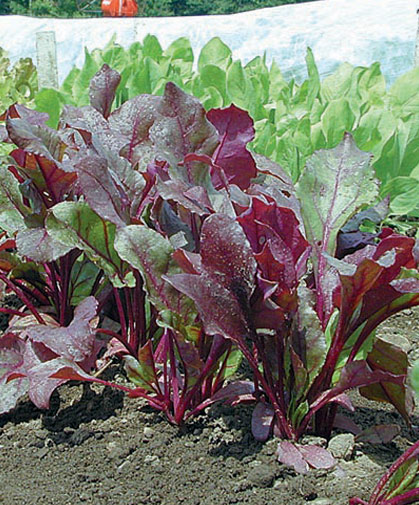Pelleted Beets - Key Growing Information

SCIENTIFIC NAME:
Beta vulgarisPELLETED SEED:
Smooth and consistently sized pelleted seeds can help reduce jamming in mechanical planters that can be caused by irregularly-shaped beet seeds. Our beet pellets are made of inert, NOP-compliant materials and are size 18.0; suitable for use with the Stanhay seeders (belt size 18.0) or many of the precision seeders offered by Johnny's. NOTE: These larger pellets may be too heavy for air or vacuum planters. Pelleted seed requires a little extra attention when it comes to watering, as it performs best with consistent, moderate soil moisture throughout the germination period. An initial watering will split or dissolve the pellet, but if the soil dries out before the germination period is over, the seed may receive insufficient moisture for optimal germination.PELLET STORAGE:
Pelleting offers many advantages, but the pelleting process also shortens the shelf life of the seed. We recommend using pelleted seed within one year of purchase. If you need to store pelleted seeds until planting, protect them from heat and humidity in a cool, dark, dry place. If you prefer to store your seed in the refrigerator, be sure to place the seed in an air-tight container to protect it from fluctuations in humidity.CULTURE:
First-rate crops grow quickly in light or loamy soils with a pH over 6.0. In general, cool temperatures produce the best flesh color. Acute weather fluctuations will cause zoning (white rings) in the roots.TRANSPLANTING:
Sow seed in a cold frame or indoors in early spring, about 5-6 weeks before transplanting out after heavy frosts become infrequent. Sow seeds 1/2" deep, 3-4 seeds per inch. Transplant out 3" apart in rows 12-18" apart.DIRECT SEEDING:
Begin early sowings when soil has warmed to 45°F/7°C. Sow 15 seeds/ft. 1/2" deep, rows 12-18" apart. Thin to 1 plant per 3". For a continuous supply of greens and small tender beets, sow seed at 2-week intervals until 8 weeks before regular heavy frosts are expected.DISEASES:
Keep beets well irrigated to prevent scab, the same disorder that affects potatoes, causing raised brown rough spots on the mature roots. Internal breakdown or browning is most likely to occur in alkaline soils after prolonged hot, dry periods. This is caused by a boron deficiency. Rotate crops to prevent Cercospora leaf spot.HARVEST AND STORAGE:
Fork or undermine, lift plants, wash and hydrocool, and store bunches 10 days at 32°F/0°C and 95% relative humidity.WINTER STORAGE OF ROOTS:
Sow about 10 weeks before heavy freeze is expected. Cut tops, wash, and store 6 months at 32°F (0°C) and 95% humidity.DAYS TO MATURITY:
From direct seeding; subtract 14-21 days if transplants are used.AVG. SEEDING RATE:
1M/66', 5M/333', 436M/acre @15 seeds/ft. and 18" between rows.SIZED SEEDS:
"Sized" seeds have been sorted so they are roughly the same size. This consistency allows for more accurate spacing with mechanical seeders and more even germination. Beet seeds are sized, except when noted in the product description.SEED SPECS:
SEEDS/LB.: Avg. 37,000.PACKET:
250 seeds, sows 23'.

